warning LUCID AIR 2022 Manual Online
[x] Cancel search | Manufacturer: LUCID, Model Year: 2022, Model line: AIR, Model: LUCID AIR 2022Pages: 241, PDF Size: 5.15 MB
Page 195 of 241

Contact a Lucid Service Center to have the
issue rectified as soon as possible.
Tire pressure correction
The tire pressure indicator light does not
automatically turn off when the tire pressure
is adjusted for all four tires.
After the tires are inflated to the correct
pressures, drive your vehicle over 18 mph
(30 km/h) to activate the Tire Pressure
Monitoring System (TPMS) and turn off the
low tire pressure indicator light.
Tire changing
Always have your tires serviced or changed by
a qualified technician.
Care must be taken to avoid contact between
the bead of the tire and the sensor during removal and refitting of the tire, otherwise
the sensor may become damaged and/or inoperable.
Replacing a tire pressure sensor
If you experience frequent low tire pressure warnings and the tire pressures are correct,
contact Lucid Service Center to determine if
a tire pressure sensor requires replacement.
Note: If a non-Lucid Service Center has
replaced a tire pressure sensor, it may not
work until it has been programmed to the
vehicle by Lucid.Tire & Wheels182
Page 196 of 241

Vehicle Loading
Loading the VehicleWARNING: Overloading the vehicle
has an adverse effect on braking and
handling characteristics, which can compromise your safety or damage
the vehicle.
It is important to understand the maximum
weight rating for your vehicle and how much
weight your vehicle can safely carry.
See the vehicle certification label located on
the driver side front door jamb, by the front
wheel, for the maximum load for your vehicle
Page 211 of 241
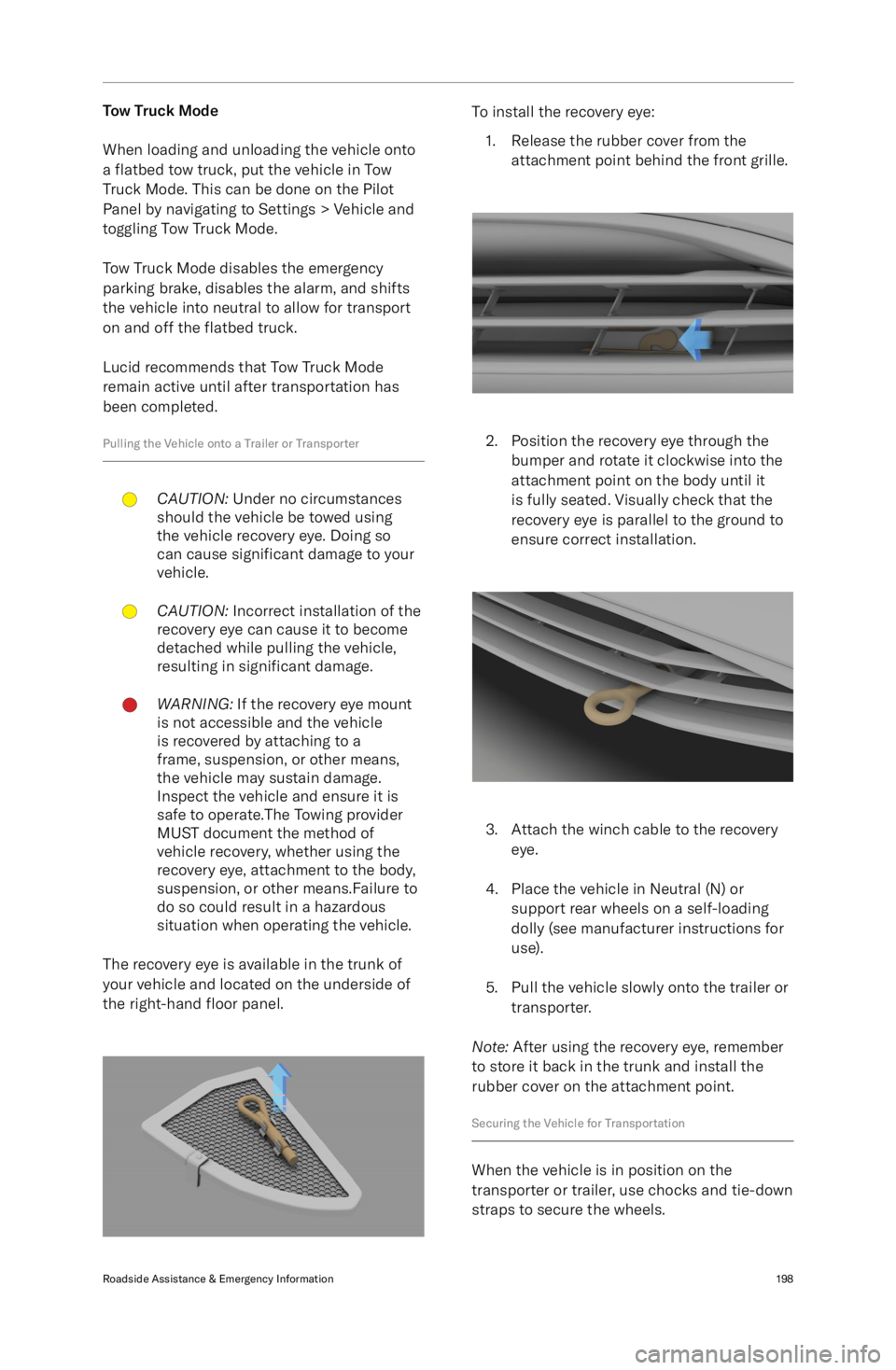
Tow Truck Mode
When loading and unloading the vehicle onto
a flatbed tow truck, put the vehicle in Tow
Truck Mode. This can be done on the Pilot
Panel by navigating to Settings > Vehicle and
toggling Tow Truck Mode.
Tow Truck Mode disables the emergency
parking brake, disables the alarm, and shifts
the vehicle into neutral to allow for transport
on and off the flatbed truck.
Lucid recommends that Tow Truck Mode
remain active until after transportation has been completed.
Pulling the Vehicle onto a Trailer or TransporterCAUTION: Under no circumstances
should the vehicle be towed using
the vehicle recovery eye. Doing so
can cause significant damage to your
vehicle.CAUTION: Incorrect installation of the
recovery eye can cause it to become
detached while pulling the vehicle,
resulting in significant damage.WARNING: If the recovery eye mount
is not accessible and the vehicle
is recovered by attaching to a
frame, suspension, or other means,
the vehicle may sustain damage.
Inspect the vehicle and ensure it is
safe to operate.The Towing provider
MUST document the method of
vehicle recovery, whether using the
recovery eye, attachment to the body,
suspension, or other means.Failure to
do so could result in a hazardous
situation when operating the vehicle.
The recovery eye is available in the trunk of
your vehicle and located on the underside of
the right-hand floor panel.
To install the recovery eye:
1. Release the rubber cover from the attachment point behind the front grille.
2. Position the recovery eye through thebumper and rotate it clockwise into the
attachment point on the body until it
is fully seated. Visually check that the
recovery eye is parallel to the ground to
ensure correct installation.
3. Attach the winch cable to the recovery eye.
4. Place the vehicle in Neutral (N) or support rear wheels on a self-loading
dolly (see manufacturer instructions for use).
5. Pull the vehicle slowly onto the trailer or transporter.
Note: After using the recovery eye, remember
to store it back in the trunk and install the
rubber cover on the attachment point.
Securing the Vehicle for Transportation
When the vehicle is in position on the
transporter or trailer, use chocks and tie-down
straps to secure the wheels.
Roadside Assistance & Emergency Information198
Page 213 of 241
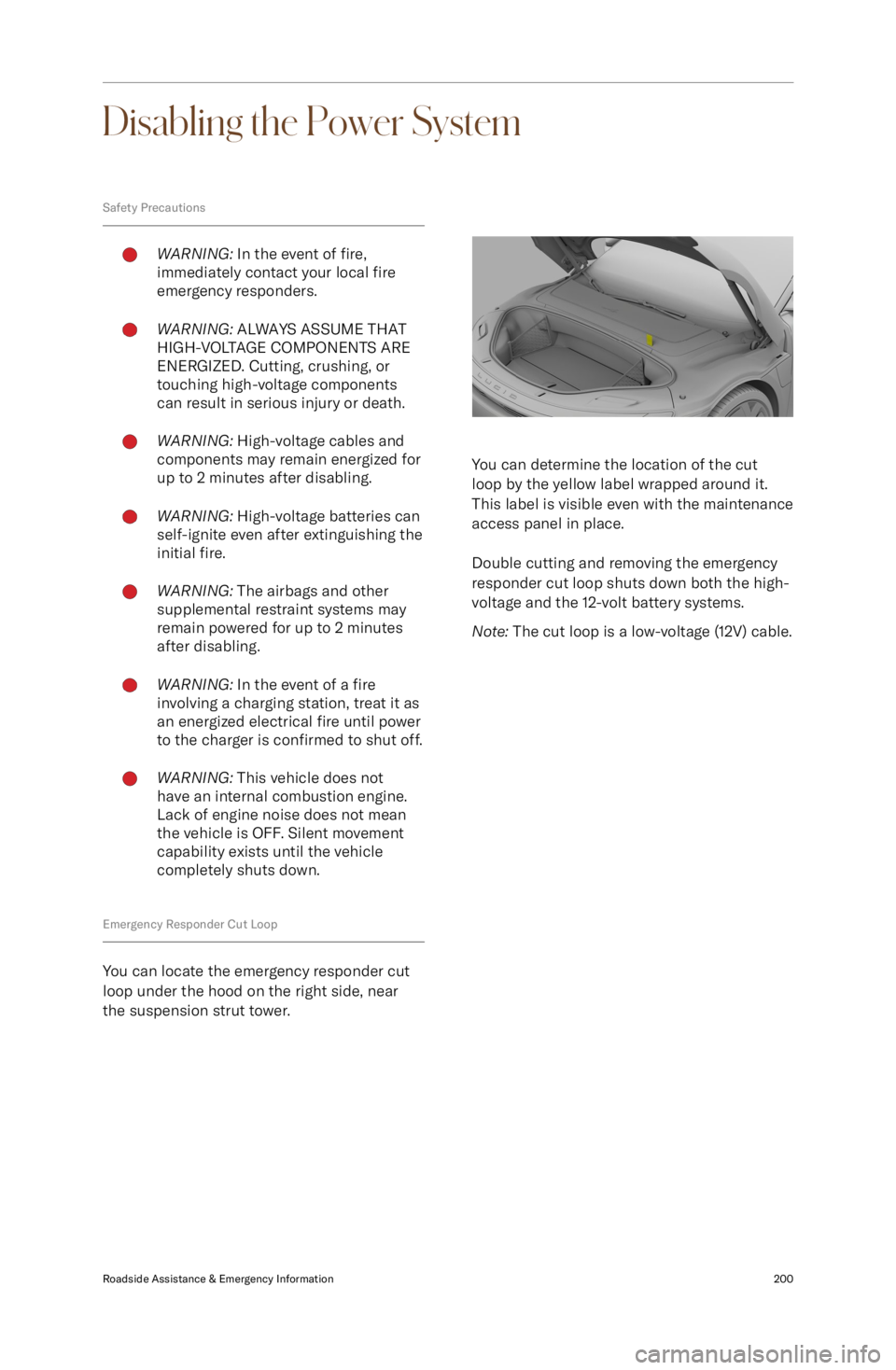
Disabling the Power System
Safety PrecautionsWARNING: In the event of fire,
immediately contact your local fire
emergency responders.WARNING: ALWAYS ASSUME THAT
HIGH-VOLTAGE COMPONENTS ARE
ENERGIZED. Cutting, crushing, or
touching high-voltage components
can result in serious injury or death.WARNING: High-voltage cables and
components may remain energized for
up to 2 minutes after disabling.WARNING: High-voltage batteries can
self-ignite even after extinguishing the
initial fire.WARNING: The airbags and other
supplemental restraint systems may
remain powered for up to 2 minutes
after disabling.WARNING: In the event of a fire
involving a charging station, treat it as
an energized electrical fire until power
to the charger is confirmed to shut off.WARNING: This vehicle does not
have an internal combustion engine.
Lack of engine noise does not mean
the vehicle is OFF. Silent movement
capability exists until the vehicle
completely shuts down.
Emergency Responder Cut Loop
You can locate the emergency responder cut
loop under the hood on the right side, near
the suspension strut tower.
You can determine the location of the cut
loop by the yellow label wrapped around it.
This label is visible even with the maintenance
access panel in place.
Double cutting and removing the emergency
responder cut loop shuts down both the high-
voltage and the 12-volt battery systems.
Note: The cut loop is a low-voltage (12V) cable.
Roadside Assistance & Emergency Information200
Page 214 of 241
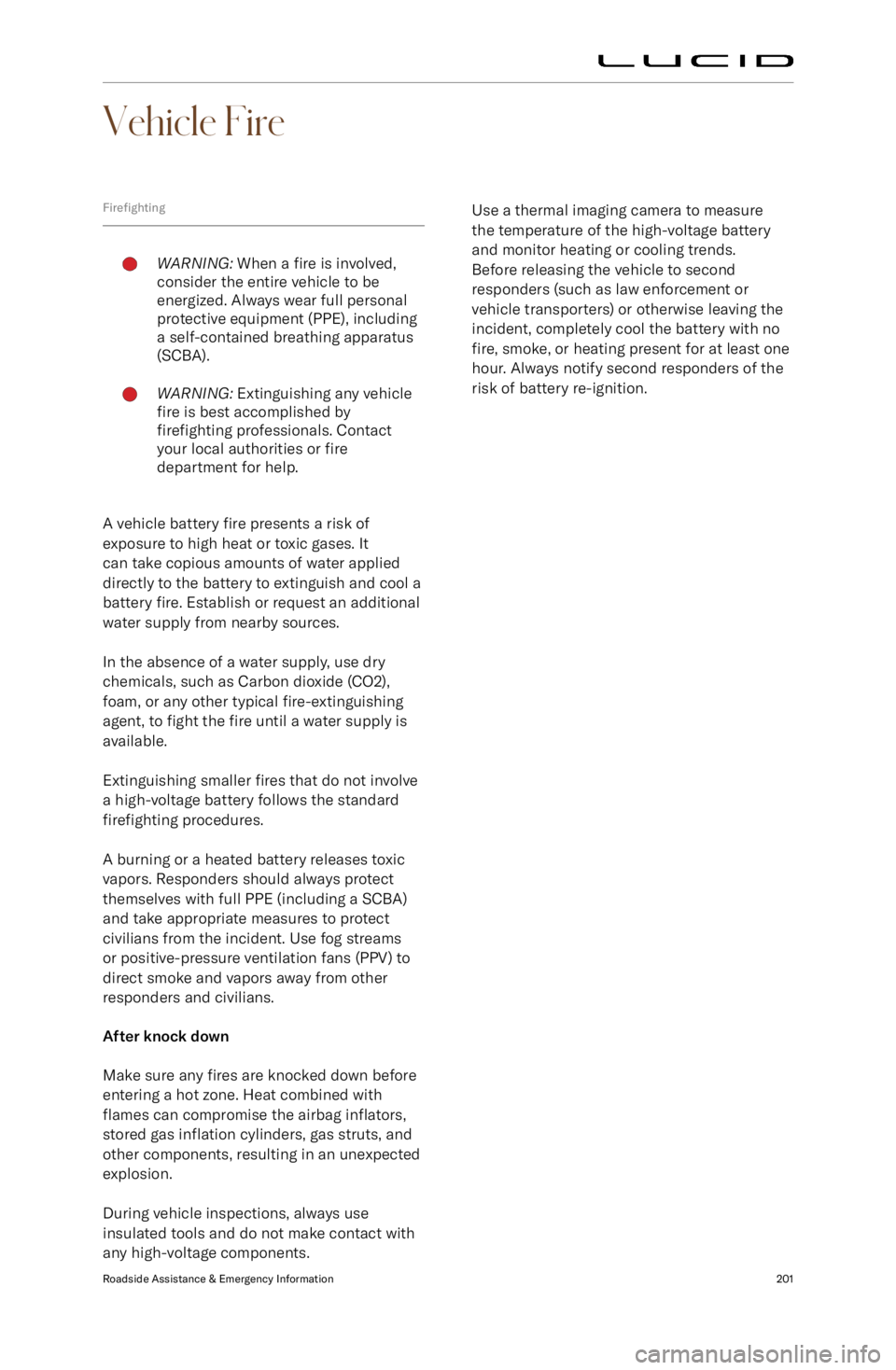
Vehicle Fire
FirefightingWARNING: When a fire is involved,
consider the entire vehicle to be
energized. Always wear full personal
protective equipment (PPE), including
a self-contained breathing apparatus
(SCBA).WARNING: Extinguishing any vehicle
fire is best accomplished by
firefighting professionals. Contact
your local authorities or fire
department for help.
A vehicle battery fire presents a risk of
exposure to high heat or toxic gases. It
can take copious amounts of water applied
directly to the battery to extinguish and cool a
battery fire. Establish or request an additional
water supply from nearby sources.
In the absence of a water supply, use dry
chemicals, such as Carbon dioxide (CO2), foam, or any other typical fire-extinguishing
agent, to fight the fire until a water supply is
available.
Extinguishing smaller fires that do not involve
a high-voltage battery follows the standard
firefighting procedures.
A burning or a heated battery releases toxic
vapors. Responders should always protect
themselves with full PPE (including a SCBA)
and take appropriate measures to protect
civilians from the incident. Use fog streams
or positive-pressure ventilation fans (PPV) to
direct smoke and vapors away from other
responders and civilians.
After knock down
Make sure any fires are knocked down before
entering a hot zone. Heat combined with
flames can compromise the airbag inflators,
stored gas inflation cylinders, gas struts, and
other components, resulting in an unexpected
explosion.
During vehicle inspections, always use
insulated tools and do not make contact with
any high-voltage components.
Use a thermal imaging camera to measure the temperature of the high-voltage battery
and monitor heating or cooling trends.
Before releasing the vehicle to second
responders (such as law enforcement or vehicle transporters) or otherwise leaving the
incident, completely cool the battery with no
fire, smoke, or heating present for at least one
hour. Always notify second responders of the
risk of battery re-ignition.Roadside Assistance & Emergency Information201
Page 220 of 241
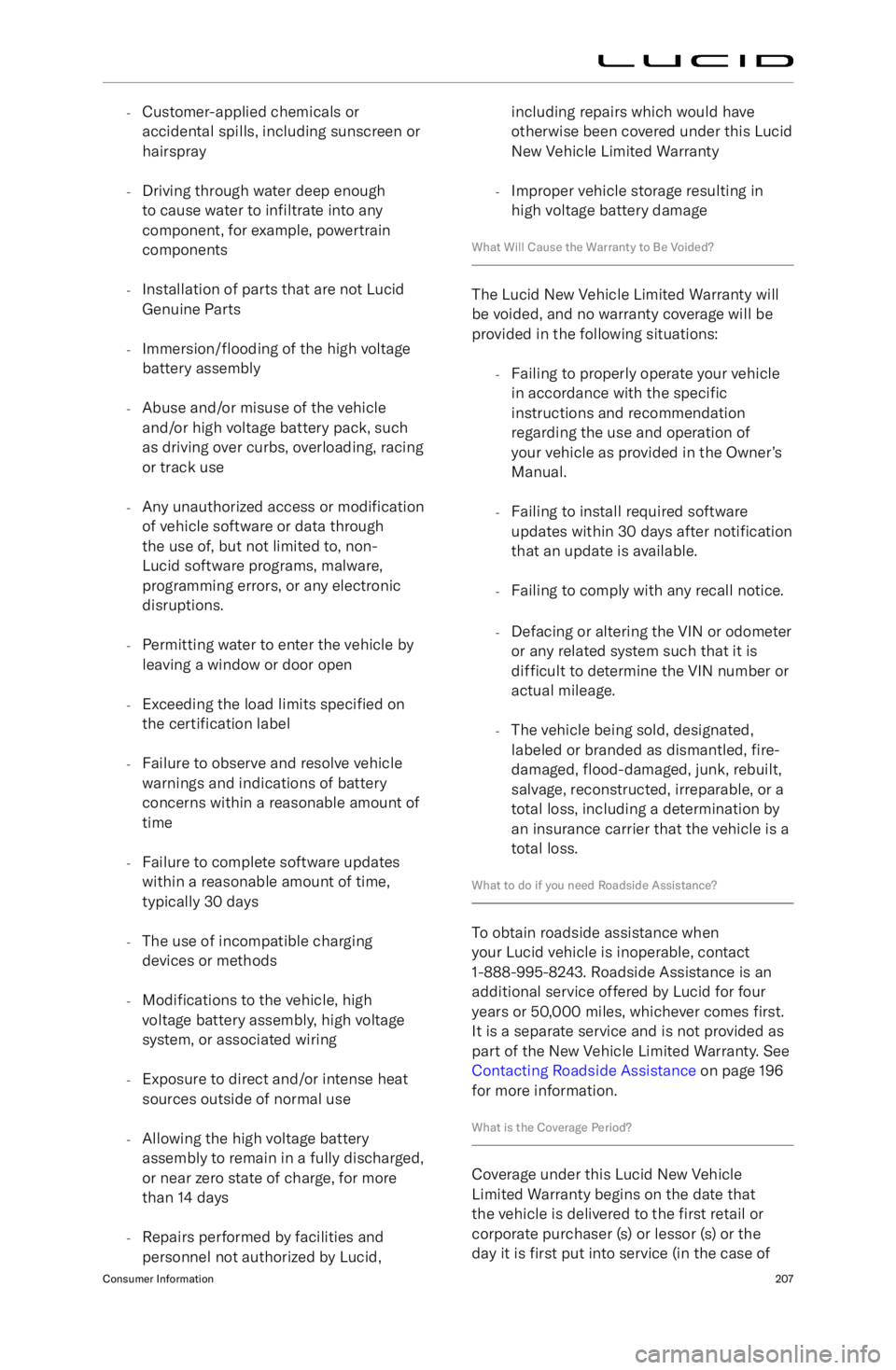
-Customer-applied chemicals or
accidental spills, including sunscreen or
hairspray
- Driving through water deep enough
to cause water to infiltrate into any
component, for example, powertrain
components
- Installation of parts that are not Lucid
Genuine Parts
- Immersion/flooding of the high voltage
battery assembly
- Abuse and/or misuse of the vehicle
and/or high voltage battery pack, such
as driving over curbs, overloading, racing
or track use
- Any unauthorized access or
modification
of vehicle software or data through
the use of, but not limited to, non-
Lucid software programs, malware,
programming errors, or any electronic
disruptions.
- Permitting water to enter the vehicle by
leaving a window or door open
- Exceeding the load limits specified on
the certification label
- Failure to observe and resolve vehicle
warnings and indications of battery
concerns within a reasonable amount of
time
- Failure to complete software updates
within a reasonable amount of time,
typically 30 days
- The use of incompatible charging
devices or methods
- Modifications to the vehicle, high
voltage battery assembly, high voltage system, or associated wiring
- Exposure to direct and/or intense heat
sources outside of normal use
- Allowing the high voltage battery
assembly to remain in a fully discharged,
or near zero state of charge, for more
than 14 days
- Repairs performed by facilities and
personnel not authorized by Lucid,including repairs which would have
otherwise been covered under this Lucid
New Vehicle Limited Warranty
- Improper vehicle storage resulting in
high voltage battery damage
What Will Cause the Warranty to Be Voided?
The Lucid New Vehicle Limited Warranty will
be voided, and no warranty coverage will be
provided in the following situations:
-Failing to properly operate your vehicle
in accordance with the specific
instructions and recommendation
regarding the use and operation of
your vehicle as provided in the Owner
Page 226 of 241
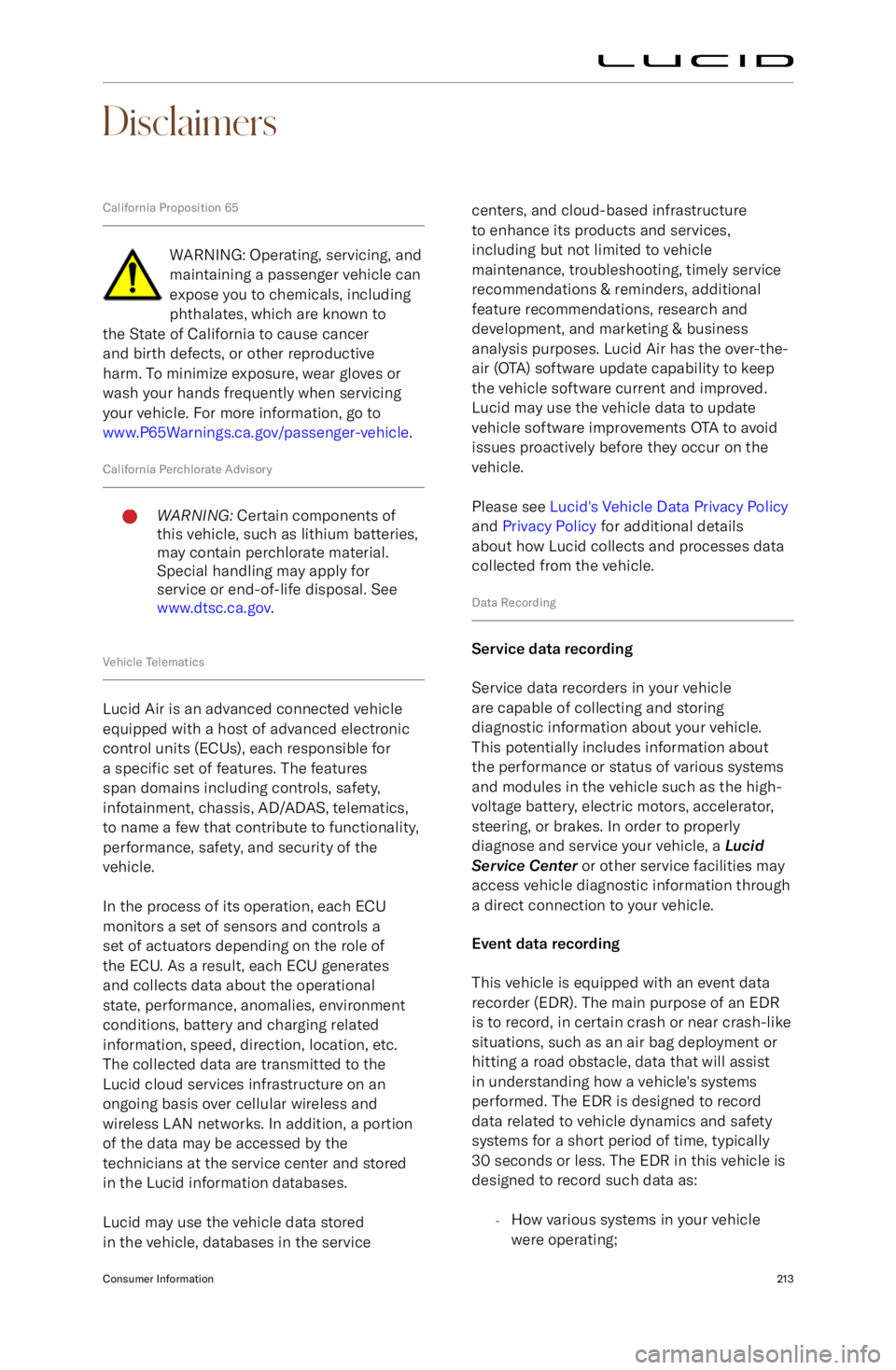
Disclaimers
California Proposition 65
WARNING: Operating, servicing, andmaintaining a passenger vehicle can
expose you to chemicals, including
phthalates, which are known to
the State of California to cause cancer
and birth defects, or other reproductive
harm. To minimize exposure, wear gloves or
wash your hands frequently when servicing
your vehicle. For more information, go to
www.P65Warnings.ca.gov/passenger-vehicle .
California Perchlorate Advisory
WARNING: Certain components of
this vehicle, such as lithium batteries,
may contain perchlorate material.
Special handling may apply for
service or end-of-life disposal. See
www.dtsc.ca.gov .
Vehicle Telematics
Lucid Air is an advanced connected vehicle
equipped with a host of advanced electronic
control units (ECUs), each responsible for
a specific set of features. The features
span domains including controls, safety,
infotainment, chassis, AD/ADAS, telematics, to name a few that contribute to functionality,
performance, safety, and security of the
vehicle.
In the process of its operation, each ECU
monitors a set of sensors and controls a
set of actuators depending on the role of
the ECU. As a result, each ECU generates
and collects data about the operational
state, performance, anomalies, environment
conditions, battery and charging related information, speed, direction, location, etc.
The collected data are transmitted to the
Lucid cloud services infrastructure on an
ongoing basis over cellular wireless and
wireless LAN networks. In addition, a portion of the data may be accessed by the
technicians at the service center and stored
in the Lucid information databases.
Lucid may use the vehicle data stored
in the vehicle, databases in the service
centers, and cloud-based infrastructure to enhance its products and services,
including but not limited to vehicle
maintenance, troubleshooting, timely service
recommendations & reminders, additional
feature recommendations, research and
development, and marketing & business
analysis purposes. Lucid Air has the over-the-
air (OTA) software update capability to keep the vehicle software current and improved.Lucid may use the vehicle data to update
vehicle software improvements OTA to avoid
issues proactively before they occur on the
vehicle.
Please see Lucid
Page 228 of 241

Vehicle Recycling
High-Voltage Battery Recycling ProcessWARNING: Attempting to disconnect
or remove the battery pack without
the proper training, tools, and
equipment is highly dangerous and
could result in serious injury or death.
Your vehicle is equipped with a liquid-cooled
lithium ion (Li-ion) high-voltage battery pack.
A battery pack must be properly recycled
when it has been damaged or has reached the
end of its useful service life.
If the vehicle can no longer hold a charge
or power on, or in the case of a collision or submersion, contact a Lucid Service Center
immediately. Have the battery pack removed from the vehicle by a Lucid Service Center
or a Lucid approved technician as soon as
possible. Do not attempt to disconnect or remove the battery pack yourself.
Lucid Service Centers will manage the
damaged or depleted battery pack and, in accordance with Lucid
Page 237 of 241

Food and Drug Administration (FDA) Compliance InformationWARNING: DO NOT attempt to remove, access, or modify the LiDAR unit in this vehicle.
The LiDAR unit is a Class I laser device subject to regulation by the FDA. There are NO
permitted service or maintenance procedures for your vehicle
Page 238 of 241
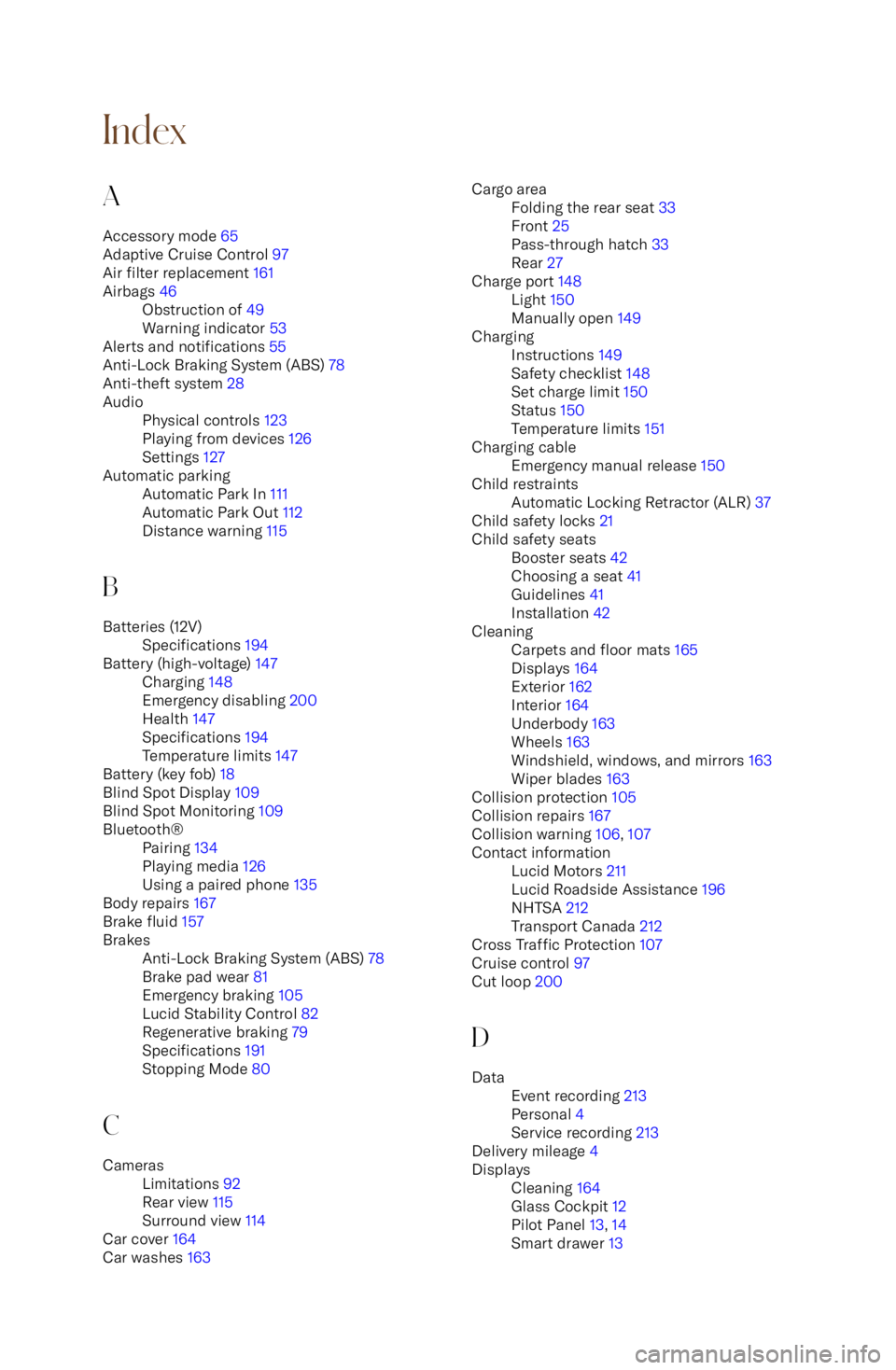
IndexA
Accessory mode 65
Adaptive Cruise Control 97
Air filter replacement 161Airbags 46Obstruction of 49
Warning indicator 53
Alerts and notifications 55
Anti-Lock Braking System (ABS) 78
Anti-theft system 28
AudioPhysical controls 123
Playing from devices 126
Settings 127Automatic parkingAutomatic Park In 111
Automatic Park Out 112
Distance warning 115
B
Batteries (12V)Specifications 194Battery (high-voltage) 147Charging 148
Emergency disabling 200
Health 147
Specifications 194
Temperature limits 147
Battery (key fob) 18
Blind Spot Display 109
Blind Spot Monitoring 109
Bluetooth